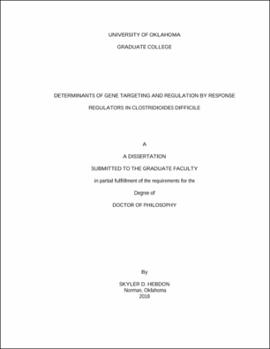| dc.contributor.advisor | West, Ann. H | |
| dc.contributor.author | Hebdon, Skyler D. | |
| dc.date.accessioned | 2018-12-10T17:12:17Z | |
| dc.date.available | 2018-12-10T17:12:17Z | |
| dc.date.issued | 2018-12-14 | |
| dc.identifier.uri | https://hdl.handle.net/11244/316297 | |
| dc.description.abstract | Bacteria use two-component signal transduction systems to sense the conditions of the environment and adapt their behavior to ensure survival. The separate roles of signal perception and response output are carried out by histidine kinase and response regulator proteins, respectively. Most response regulators alter gene transcription, but it is not yet possible to predict which genes they regulate. The precise prediction of these gene regulatory outputs could enable researchers to predict, and doctors and patients to mitigate, various bacterial behaviors.
This dissertation presents the elucidation of the genes and biological functions regulated by two response regulators, RR_1586 and RR_1677, from the hypervirulent human pathogen Clostridioides difficile R20291. The data presented herein supports the conclusion that RR_1586 regulates genes involved in phosphate transport, and further characterization of its activity suggests several mechanisms it uses to regulate those genes. The bacterial one-hybrid assay used in this study to elucidate the gene regulatory targets of RR_1586 could potentially be used to find a generalizable solution to predicting gene targets of all response regulators from genome sequences alone. In the process of optimizing the bacterial one-hybrid assay for such a broadly impactful endeavor, it was found that RR_1677 appears to regulate the processes of protein synthesis and cell wall synthesis. A bioinformatics pipeline was also constructed by combining several existing utilities to analyze and interpret the experimental results.
Two additional lines of research are also presented. The first is the adaptation of Fourier-transform infrared spectroscopy to observe response regulator phosphorylation. This method offers an alternative from the more labor-intensive methods currently available. The second is an analysis of the biophysical interactions between a response regulator from Saccharomyces cerevisiae and its binding partner, a histidine-containing phosphotransfer protein. Characterization of this interaction elucidates the physical impetus behind the evolutionary conservation of a specific glycine residue near the active site whose role was previously unknown. | en_US |
| dc.language | en_US | en_US |
| dc.subject | Two-component signal transduction | en_US |
| dc.subject | response regulator | en_US |
| dc.subject | DNA binding | en_US |
| dc.subject | regulon | en_US |
| dc.subject | bioinformatics | en_US |
| dc.subject | Clostridioides difficile | en_US |
| dc.title | Determinants of gene targeting and regulation by response regulators in Clostridioides difficile | en_US |
| dc.contributor.committeeMember | Richter-Addo, George B. | |
| dc.contributor.committeeMember | Bourne, Christina | |
| dc.contributor.committeeMember | Karr, Elizabeth A. | |
| dc.contributor.committeeMember | Yip, Ivan | |
| dc.date.manuscript | 2018-12 | |
| dc.thesis.degree | Ph.D. | en_US |
| ou.group | College of Arts and Sciences::Department of Chemistry and Biochemistry | en_US |
